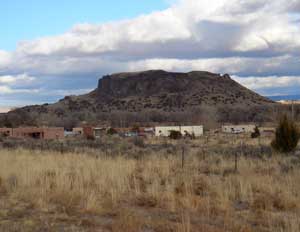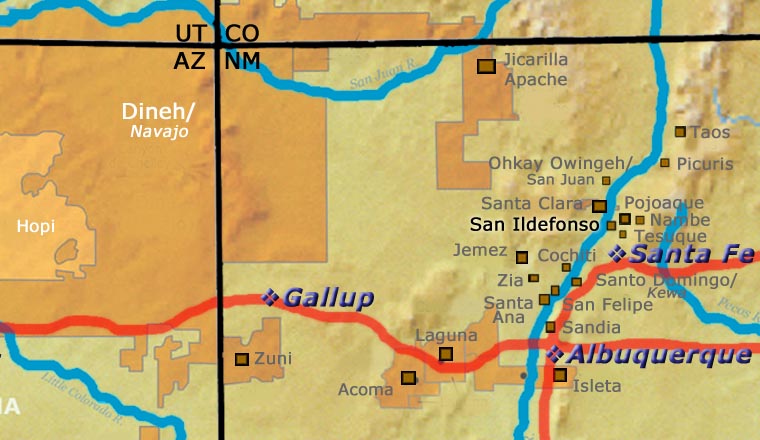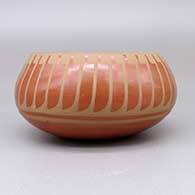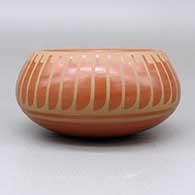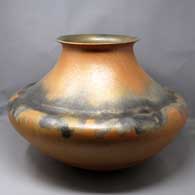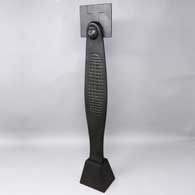
Blue Corn
San Ildefonso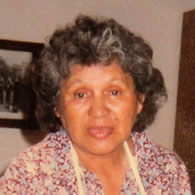
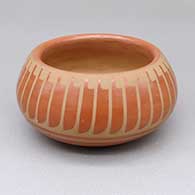
Blue Corn (1921-1999) was a potter from San Ildefonso Pueblo. She was born Crucita Gonzalez. The name Blue Corn was given to her by one of Maria Martinez' sisters during her San Ildefonso naming ceremony.
Blue Corn made her first piece of pottery at the age of three. She said her grandmother told her, "Your hands were made for pottery." That was a prophetic statement because Blue Corn made pottery for nearly her entire life.
She was born in that time when many Native American children were being educated in boarding schools. She was educated at the Santa Fe Indian School, about 25 miles from home. Both her parents died while she was away at school. Summers were spent in her grandmother's home until she graduated and was sent to live with relatives in southern California.
For a while she worked as a maid in a Beverly Hills mansion. Then she returned to New Mexico and met Artillery Sergeant Santiago Calabazas. He, too, was an orphan and was educated in boarding schools. Neither of them had graduated high school. They fell in love but World War II was on. After the war he returned to Santo Domingo and resumed his career as a silversmith. Then he and Blue Corn married. In keeping with Pueblo tradition he moved to her home at San Ildefonso.
In those years Blue Corn worked as a housekeeper for J. Robert Oppenheimer, the famous nuclear physicist who was the founder and first Director of Los Alamos National Laboratory. She began making pottery after her first son, Joseph, was born.
Blue Corn was especially known for her polychrome designs on cream-colored jars and plates. She and Santiago spent several years experimenting with different techniques, forms, clays and colors.
Blue Corn produced a significant number of redware and blackware pieces through the years. By the late 1960s she was emerging as a leader in the revival of polychrome pottery. She was known for highly polished white, cream and buff slips, which she said she produced by polishing very slowly. She also selected subtle colors of clay with which to paint her designs.
Santiago passed away in 1972 and their son Joseph took his place in helping Blue Corn make her pottery. He made a few pieces of his own, too, signing them Tho Ma Thay.
Blue Corn was known for making jars, plates, wedding vases, oval blackware lidded boxes and black-on-black owl figures. Her favorite designs included feathers, rain clouds, turtles and the avanyu (the Tewa water serpent).
She did demonstrations and exhibitions all around the country and participated in shows like the Santa Fe Indian Market and the New Mexico State Fair, earning major awards at both. In 1981 she was awarded the 8th Annual Governor's Award, the highest artistic honor awarded by the State of New Mexico.
When she died, Blue Corn had raised 10 children and they had given her 18 grandchildren and 10 great-grandchildren. She had also taught many people how to make pottery, including most of her own children. Some of them went on to become award-earning potters in their own right.
Some Exhibits that Featured Blue Corn's Work
- Gifts from the Community. Heard Museum West. April 12, 2008 - October 12, 2008
- Choices and Change: American Indian Artists in the Southwest. Heard Museum North. Scottsdale, AZ. 2007
- Home: Native Peoples in the Southwest. Heard Museum. Phoenix, AZ. 2005
- Breaking the Surface: Carved Pottery Techniques and Designs. Heard Museum. Phoenix, AZ. 2004
- Hold Everything! Masterworks of Pottery and Basketry from the Heard Museum. Heard Museum. Phoenix, AZ. 2001
- Images, Artists, Styles: Recent Acquisitions from the Heard Museum Collection. Heard Museum North. Scottsdale, AZ. 2001
- Lovena Ohl: An Eye for Art, A Heart for Artists. Heard Museum. Phoenix, AZ. 2000
- Legacy of Generations: Pottery by American Indian Women. Heard Museum. Phoenix, AZ. 1998
- Recent Acquisitions from the Herman and Claire Bloom Collection. Heard Museum. Phoenix, AZ 1997
- Lovena Ohl Gallery. Scottsdale, AZ. 1994
- Rain. Heard Museum. Phoenix, AZ. 1993
- Dancing Across Time: Indian Images of the Southwest. American Contemporary Arts. San Francisco, CA. 1995
- Blue Corn and Al Nez. Lovena Ohl Gallery. Scottsdale, AZ. 1991
- Al Nez, Norma Antone, Blue Corn and Elk Woman. Lovena Ohl Gallery. Scottsdale, AZ. 1990
- Seven Families in Pueblo Pottery. Simply Santa Fe. Santa Fe, NM. 1990
- 18th Anniversary Show. Pacific Western Traders. Folsom, CA. 1989
- Phil Poseyesva and Blue Corn. Lovena Ohl Gallery. Scottsdale, AZ. 1989
- Breaking the Surface: Carved Pottery Techniques and Designs. Heard Museum. Phoenix, AZ. 2004
- Indian Art for the Home. Lovena Ohl Gallery. Scottsdale, AZ. 1988
- San Ildefonso Pottery: Blue Corn. Heard Museum. Phoenix, AZ. 1988
- Al Nez and Blue Corn. Lovena Ohl Gallery. Scottsdale, AZ. 1987
- Mother Earth, Father Sky. University of Southern California. Idyllwild, CA. 1987
- 1987 Group Show. Lovena Ohl Gallery. Scottsdale, AZ.
- 1986 Group Show. Robert Dean Gallery. Scottsdale, AZ. Dennis Tewa, Michael Kabotie and Blue Corn. Lovena Ohl Gallery. Scottsdale, AZ. 1986
- Celebrate the Spirit. Felicita Foundation for the Arts. Mathes Cultural Center. Escondido, CA. 1985
- Art for Life. Scottsdale Center for the Arts. Scottsdale, AZ. 1983
- 1983 Group Show. Gallery 10. Scottsdale, AZ.
- Larry Grolsch, Blue Corn and Robert Redbird. Lovena Ohl Gallery. Scottsdale, AZ. 1982
- Seven Pueblo Potters. Lovena Ohl Gallery. Scottsdale, AZ. 1982
- 1982 Autumn Market. Pacific Western Traders. Folsom, CA.
- American Indian Pottery and Baskets: Art Deco Design. L'Omega Gallery. Kansas City, MO. 1981
- Art of the Southwest. Pacific Western Traders. Folsom, CA. 1980
- The Santa Fe Indian Market in Perspective. Wheelwright Museum of the American Indian. Santa Fe, New Mexico. August 1979 - September 24, 1979
- Images from the Earth. Institute of American Indian Arts. Santa Fe, NM. 1978
- Feature Artists for the 1977-1978 Season. Tanner's Indian Arts. Scottsdale, AZ. 1977
- Ceramics: New Mexico. University of New Mexico. Albuquerque, NM. 1974
- Eighth Scottsdale National Indian Arts Exhibition. Executive House. Scottsdale, AZ. 1969
- Seventh Scottsdale National Indian Arts Exhibition. Executive House. Scottsdale, AZ. 1968
Some Awards Blue Corn Earned
- 1993 Santa Fe Indian Market. Class II - Pottery, Div. F - Traditional, Second Place;
- Div. E - Traditional, Second Place - 1986 Santa Fe Indian Market. Class II - Pottery, Div. E - Traditional, Cat. 1107 - Plates, Third Place;
- Div. H - Non-traditional, Cat. 1309 - jewelry, First Place;
- Div. D - Traditional Pottery, Carved, Cat. 1006 - Plates, First Place - 1981 Eight Annual Governor's Award. Albuquerque, NM.
- 1978 Heard Museum Guild Indian Arts and Crafts Exhibit, Classification VII, Division C - Miniatures: Honorable Mention. Awarded for artwork: Polychrome bowl
- 1977 Heard Museum Guild Indian Arts and Crafts Exhibit. Heard Museum. Phoenix, AZ. Class V - Baskets, Cat. D - Other Traditional, First Place
- 1973 Heard Museum Guild Indian Arts and Crafts Exhibit, Classification XII - Pottery, Division A - Traditional shapes and designs: Second Place
- 1969 Eighth Scottsdale National Indian Arts Exhibition. Executive House. Scottsdale, AZ. Section B - Crafts. Classification VII - Pottery, Section 2 - New Mexico: Second Place
- 1968 Seventh Scottsdale National Indian Arts Exhibition. Executive House. Scottsdale, AZ. Section B - Crafts, Classification IX - Pottery, Division A - Traditional, Section 2 - New Mexico: First Place and Honorable Mention
100 West San Francisco Street, Santa Fe, New Mexico 87501
(505) 986-1234 - www.andreafisherpottery.com - All Rights Reserved

San Ildefonso Pueblo
San Ildefonso Pueblo is located about twenty miles northwest of Santa Fe, New Mexico, mostly on the eastern bank of the Rio Grande. Although their ancestry has been traced to prehistoric pueblos in the Mesa Verde area, their most recent ancestral home is in the area of Bandelier National Monument, the prehistoric village of Tsankawi in particular. Tsankawi abuts the reservation on its northwest side.
A mission church was built in 1617 and named for San Ildefonso. Hence the name. Before that the village was called Powhoge, "where the water cuts through" (in Tewa). Today's pueblo was established as long ago as the 1300s. When the Spanish arrived in 1540, they estimated the village population at about 2,000.
That mission was destroyed during the Pueblo Revolt of 1680 and when Don Diego de Vargas returned to reclaim the San Ildefonso area in 1694, he found virtually all the Tewa people on top of nearby Black Mesa. After an extended siege the two sides negotiated a treaty and the people returned to their villages. However, the next 250 years were not good for them. The Spanish swine flu pandemic of 1918 reduced the pueblo's population to about 90. Their population has grown to more than 600 now but the only economic activity available on the pueblo involves creating art in one form or another. The only other work is off-pueblo. San Ildefonso's population is small compared to neighboring Santa Clara Pueblo, but the pueblo maintains its own religious traditions and ceremonial feast days.
San Ildefonso is most known for being the home of the most famous Pueblo Indian potter, Maria Martinez. Many other excellent potters from this pueblo have produced quality pottery, too, among them: Blue Corn, Tonita and Juan Roybal, Dora Tse Pe and Rose Gonzales. Of course the descendants of Maria Martinez are still important pillars of San Ildefonso's pottery tradition. Maria's influence reached far and wide, so far and wide that even Juan Quezada of the Mata Ortiz pottery renaissance in Chihuahua, Mexico, came to San Ildefonso to learn from her.
100 West San Francisco Street, Santa Fe, New Mexico 87501
(505) 986-1234 - www.andreafisherpottery.com - All Rights Reserved

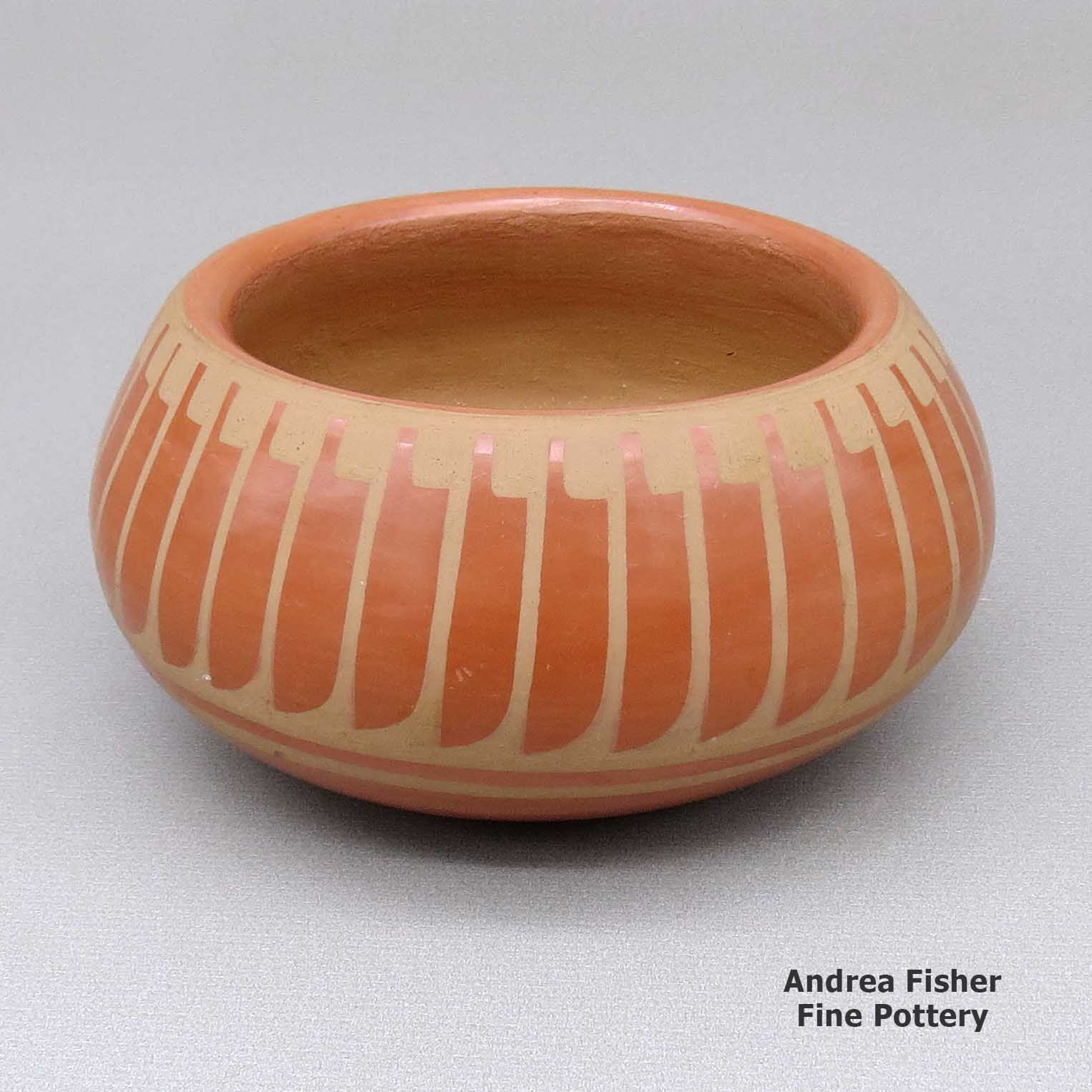
Blue Corn, San_Ildefonso, Red-on-redbowlwithamicaceousgoldslipinteriorandapaintedfeatherringgeometricdesign
San Ildefonso
$ SOLD
josi3k108
Red-on-red bowl with a micaceous gold slip interior and a painted feather ring geometric design
4.5 in L by 4.5 in W by 2.5 in H
Condition: Very good, adhesive residue on bottom and marks on side
Signature: Blue Corn San Ildefonso Pueblo
100 West San Francisco Street, Santa Fe, New Mexico 87501
(505) 986-1234 - www.andreafisherpottery.com - All Rights Reserved

Micaceous Clay Pottery

Angie Yazzie
Taos
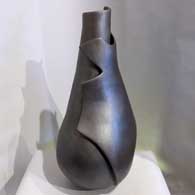
Christine McHorse
Navajo
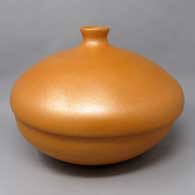
Clarence Cruz
San Juan/Ohkay Owingeh
Micaceous clay pots are the only truly functional Pueblo pottery still being made. Some special micaceous pots can be used directly on the stove or in the oven for cooking. Some are also excellent for food storage. Some people say the best beans and chili they ever tasted were cooked in a micaceous bean pot. Whether you use them for cooking or storage or as additions to your collection of fine art, micaceous clay pots are a beautiful result of centuries of Pueblo pottery making.
Between Taos and Picuris Pueblos is US Hill. Somewhere on US Hill is a mica mine that has been in use for centuries. Excavations of ancient ruins and historic homesteads across the Southwest have found utensils and cooking pots that were made of this clay hundreds of years ago.
Not long ago, though, the making of micaceous pottery was a dying art. There were a couple potters at Taos and at Picuris still making utilitarian pieces but that was it. Then Lonnie Vigil felt the call, returned to Nambe Pueblo from Washington DC and learned to make the pottery he became famous for. His success brought others into the micaceous art marketplace.
Micaceous pots have a beautiful shimmer that comes from the high mica content in the clay. Mica is a composite mineral of aluminum and/or magnesium and various silicates. The Pueblos were using large sheets of translucent mica to make windows prior to the Spaniards arriving. It was the Spanish who brought a technique for making glass. There are eight mica mining areas in northern New Mexico with 54 mines spread among them. Most micaceous clay used in the making of modern Pueblo pottery comes from several different mines near Taos Pueblo.
As we understand it, potters Robert Vigil and Clarence Cruz have said there are two basic kinds of micaceous clay that most potters use. The first kind is extremely micaceous with mica in thick sheets. While the clay and the mica it contains can be broken down to make pottery, that same clay has to be used to form the entire final product. It can be coiled and scraped but that final product will always be thicker, heavier and rougher on the surface. This is the preferred micaceous clay for making utilitarian pottery and utensils. It is essentially waterproof and conducts heat evenly.
The second kind is the preferred micaceous clay for most non-functional fine art pieces. It has less of a mica content with smaller embedded pieces of mica. It is more easily broken down by the potters and more easily made into a slip to cover a base made of other clay. Even as a slip, the mica serves to bond and strengthen everything it touches. The finished product can be thinner and have a smoother surface. As a slip, it can also be used to paint over other colors of clay for added effect. However, these micaceous pots may be a bit more water resistant than other Pueblo pottery but they are not utilitarian and will not survive utilitarian use.
While all micaceous clay from the area of Taos turns golden when fired, it can also be turned black by firing in an oxygen reduction atmosphere. Black fire clouds are also a common element on golden micaceous pottery.
Mica is a relatively common component of clay, it's just not as visible in most. Potters at Hopi, Zuni and Acoma have produced mica-flecked pottery in other colors using finely powdered mica flakes. Some potters at San Ildefonso, Santa Clara, Jemez and San Juan use micaceous slips to add sparkle to their pieces.
Potters from the Jicarilla Apache Nation collect their micaceous clay closer to home in the Jemez Mountains. The makeup of that clay is different and it fires to a less golden/orange color than does Taos clay. Some clay from the Picuris area fires less golden/orange, too. Christine McHorse, a Navajo potter who married into Taos Pueblo, uses various micaceous clays on her pieces depending on what the clay asks of her in the flow of her creating.
There is nothing in the makeup of a micaceous pot that would hinder a good sgraffito artist or light carver from doing her or his thing. There are some who have learned to successfully paint on a micaceous surface. The undecorated sparkly surface in concert with the beauty of simple shapes is a real testament to the artistry of the micaceous potter.
100 West San Francisco Street, Santa Fe, New Mexico 87501
(505) 986-1234 - www.andreafisherpottery.com - All Rights Reserved

Gonzales Family Tree
Disclaimer: This "family tree" is a best effort on our part to determine who the potters are in this family and arrange them in a generational order. The general information available is questionable so we have tried to show each of these diagrams to living members of each family to get their input and approval, too. This diagram is subject to change should we get better info.
-
Ramona Sanchez Gonzales (1885-), second wife of Juan Gonzales (painter)
- Rose (Cata) Gonzales (daughter-in-law) (1900-1989) & Robert Gonzales (1900-1935)
- (Johnnie) Tse-Pe (Gonzales)(1940-2000) & Dora Tse-Pe (Gachupin, first wife, Zia, 1939-2022)
- Andrea Tse Pe (1975-)
- Candace Tse-Pe (1968-)
- Gerri Tse-Pe (1963-)
- Irene Tse-Pe (1961-)
- Jennifer Tse-Pe (1960-1977)
- (Johnnie) Tse-Pe (1940-2000) & Jennifer Tse Pe (Sisneros - second wife, Santa Clara)
- (Johnnie) Tse-Pe (Gonzales)(1940-2000) & Dora Tse-Pe (Gachupin, first wife, Zia, 1939-2022)
- Blue Corn (Crucita Gonzales Calabaza)(1921-1999)(step-daughter of Ramona) & Santiago Calabaza (Santo Domingo) (d. 1972)
- Joseph Calabaza (Tha Mo Thay)
- Diane Calabaza-Jenkins (Heishi Flower) (1955-)
- Elliot Calabaza
- Juanita Gonzales (1909-1988) & Louis "Wo-Peen" Gonzales (brother of Rose Gonzales husband)(1905-1992)
- Adelphia Martinez (1935-2022)
- Lorenzo Gonzales (1922-1995)(adopted by Louis & Juanita Gonzales) & Delores Naquayoma (Hopi/Winnebago)
- Jeanne M. Gonzales (1959-)
- John Gonzales (1955-)
- Laurencita Gonzales
- Linda Gonzales
- Marie Ann Gonzales
- Raymond Gonzales
- Robert Gonzales
- Oqwa Pi (Abel Sanchez)(1899-1971) & Tomasena Cata Sanchez (1903-1985)
- Skipped generation
- Russell Sanchez (1966-)
- Skipped generation
Rose' students:
Some of the above info is drawn from Pueblo Indian Pottery, 750 Artist Biographies, by Gregory Schaaf, © 2000, Center for Indigenous Arts & Studies
Other info is derived from personal contacts with family members and through interminable searches of the Internet.
(505) 986-1234 - www.andreafisherpottery.com - All Rights Reserved
